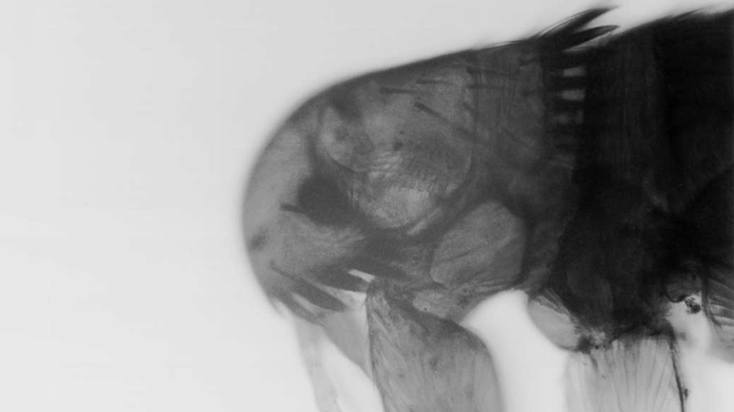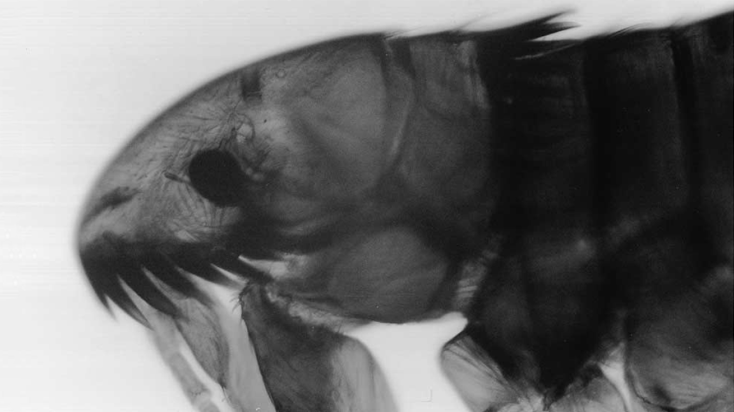
Img 1 (A) Ctenocephalides felis (B) Ctenocephalides canis (C) Xenopsylla cheopis (D) C. felis (closeup of head) (E) C. canis (closeup of head) (F) X. cheopis (closeup of head) (arrow, divided mesopleuron) (G) Pulex irritans (H) P. irritans (closeup of head) (I) Tunga penetrans
Summary
Human fleas (Pulex irritans) are 2.5 mm long. Human fleas lack combs (dark rows of bristles on their heads), which easily distinguishes them from the heavily combed C. felis and C. canis, the two most common species. P. irritans have larger eye spots than other common flea species. The human flea’s head is short and round.
Details
Most Common Flea Species
The cat flea (Ctenocephalides felis) accounts for nearly all domestic infestations, on both cats and dogs. The second most common species is the dog flea (Ctenocephalides canis). Human fleas (Pulex irritans) and poultry sticktight fleas (Echidnophaga gallinacea) are sometimes found on pets and in homes, but they are fairly rare. See Are cat and dog fleas the same? for more details.
Fleas without Pets
Homes with dogs or cats typically get infested with cat fleas (C. felis), or possibly dog fleas (C. canis). Without pets, there’s a greater chance of human fleas (P. irritans) being the culprit. P. irritans is the only species that can survive and reproduce on human blood. Cat fleas and dog fleas can’t survive without an animal host.
Still, homes without pets aren’t guaranteed to have human fleas. If a home was recently inhabited, there may be remnants of a cat flea infestation from previous tenant’s pets. There could also be mice or rats in the home, leading to rodent flea species. Or there may be a bird nesting near a window or door, and then bird fleas could find their way indoors.
Identifying Flea Species
Flea species are typically identified by examining heads, as well as other microscopic body features. Some of the distinguishing features include the presence or absence of genal or pronotal combs, number and location of various setae and bristles, structure of various plates on the body, and male genitalia.
Please view our page on What do fleas look like? for an in-depth description. That page will describe cat fleas (C. felis). However, fleas of all species share many of the same general characteristics.
What do Human Fleas (P. irritans) Look Like?

Img 2 Head of a human flea (Pulex irritans)
Pronotal and Genal Combs
An easily noticeable feature that separates P. irritans from C. felis and C. canis is the absence of combs. Combs are rows of dark, thick bristles. They can occur in two locations. Genal combs are found on the bottom of the head, near the “mouth”. Pronotal combs are found near the posterior of the head.
C. felis and C. canis have prominent genal combs and pronotal combs Img 1, 3 & 4. P. irritans doesn’t have any combs Img 1 & 2.
The oriental rat flea (X. cheopis) and sticktight flea (E. gallinacea) are two other species that don’t have combs. Below are details on how to differentiate them from human fleas.

Img 3 Head of a dog flea (Ctenocephalides canis)

Img 4 Head of a cat flea (Ctenocephalides felis)
Undivided mesopleuron
The combless X. cheopis can be distinguished from P. irritans because it has a mesopleuron divided by internal scleritization Img 1 (F).
Size
P. irritans average 2.5 mm in size. Females are larger than males, 2.94 mm and 1.96 mm, respectively. This is similar to the size of cat fleas. However, P. irritans is about twice the size of E. gallinacea, the other combless species.
Eyes
P. irritans has large eyespots compared to other common flea species Img 1.
Head Shape
P. irritans has a short head, with a rounded front margin Img 1 & 2. C. canis also has a short round head Img 1 & 3. C. felis has a much longer head, and it is slightly convex Img 1 & 4. E. gallinacea has a short head, but it is much more angular than other species, with a flat front margin Img 5.

Img 5 Sticktight flea E. gallinacea




You must log in to post a comment. Log in now.